Celebrating a Lifetime of Service to Public Health
A Career in Two Splendid Acts

Having led the nation’s efforts in HIV/AIDS prevention for 15 years before joining the Rollins School of Public Health as dean, Dr. James Curran has brought consummate skill to Emory’s youngest school: in faculty and student recruitment and retention, in expanding the curriculum and strengthening research, and in fundraising and budget management. Rankings attest to the school’s preeminence, but the story lies in the pride that faculty, students, staff, alumni, and donors feel in the school and the gratitude they have for the man at the top—still brimming with plans as he prepares to hand the reins to his successor.

The year was 1995, and these were the blunt words of Dr. Charles R. Hatcher Jr. to the new dean of Rollins School of Public Health, James W. Curran: “The school has grown too fast. You have to balance the budget. Calm down. You have a new building. Enjoy it.”
Hatcher was vice president for health affairs and director of the Woodruff Health Sciences Center. More important, he was Curran’s new boss.
The new dean had barely unpacked. Though this might evidence a crushingly short honeymoon period, Curran appreciated the honesty and was ready to put the young school, founded just five years previously, on the right path. He needed just a year to carry out Hatcher’s plan and formulate some ambitious ones of his own, adroitly managing the budget at the same time as he initiated expansion across the board. “We have been in the black every year since I started. And we haven’t stopped growing,” says Curran.
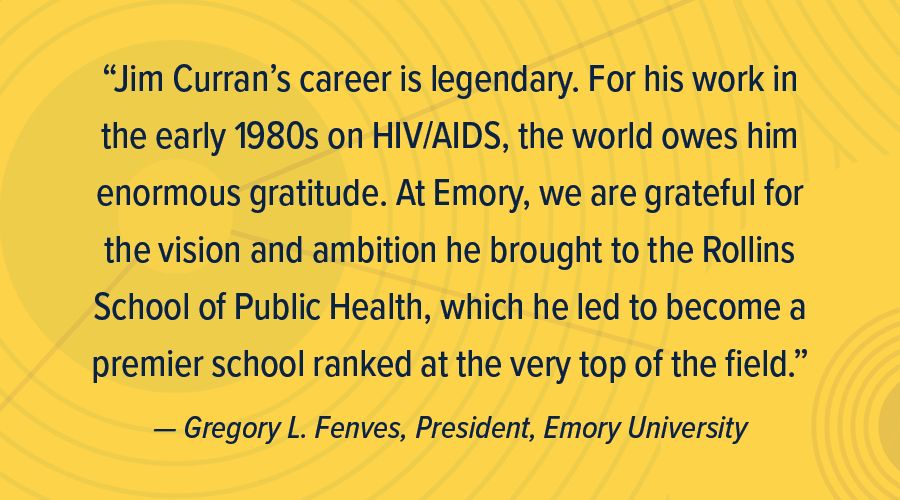
Now in his 26th year, he announced in April that although he will remain with the school as a professor of epidemiology, he is stepping down as dean once a successor arrives. Until then, the man who confesses that he “doesn’t retire easily or often” remains as energetic as ever.
That additional time with the dean has been welcome news to President Gregory L. Fenves.
“Jim Curran’s career is legendary. For his work in the early 1980s on HIV/AIDS, the world owes him enormous gratitude,” says Fenves. “At Emory, we are grateful for the vision and ambition he brought to the Rollins School of Public Health, which he led to become a premier school ranked at the very top of the field, and for bringing together other key agencies to make Atlanta one of the public health capitals of the world.”

Growth, Curran-style

In fall 2021, Rollins welcomed its largest class yet—nearly 700 master’s students, representing 39 countries and 44 states, who study in six departments. In partnership with the Laney Graduate School, Rollins hosts seven PhD programs. There is also a highly regarded executive MPH.
US News & World Report ranks Rollins No. 4, and it is the only school of public health founded in the past 80 years to be ranked in the top five. The school is No. 4 in National Institutes of Health (NIH) funding, at $58.9 million in FY 2020, and total sponsored research in 2020–2021 was $127 million.
“Jim Curran’s extraordinary vision and leadership helped establish the Rollins School of Public Health as a world leader in public health education and research,” says Jonathan Lewin, executive vice president for health affairs, Emory University; executive director, Woodruff Health Sciences Center; and CEO and chair of the board, Emory Healthcare. “It’s humbling to reflect on the extraordinary impact of Jim’s leadership and his groundbreaking and lifesaving decades of work. He leads not only with a focus on enhancing the positive trajectory of the school, but also with a clear and passionate vision for improving global public health.”


In fall 2021, Rollins welcomed its largest class yet—nearly 700 master’s students, representing 39 countries and 44 states, who study in six departments. In partnership with the Laney Graduate School, Rollins hosts seven PhD programs. There is also a highly regarded executive MPH.
US News & World Report ranks Rollins No. 4, and it is the only school of public health founded in the past 80 years to be ranked in the top five. The school is No. 4 in National Institutes of Health (NIH) funding, at $58.9 million in FY 2020, and total sponsored research in 2020–2021 was $127 million.
“Jim Curran’s extraordinary vision and leadership helped establish the Rollins School of Public Health as a world leader in public health education and research,” says Jonathan Lewin, executive vice president for health affairs, Emory University; executive director, Woodruff Health Sciences Center; and CEO and chair of the board, Emory Healthcare. “It’s humbling to reflect on the extraordinary impact of Jim’s leadership and his groundbreaking and lifesaving decades of work. He leads not only with a focus on enhancing the positive trajectory of the school, but also with a clear and passionate vision for improving global public health.”
‘Key man’

Curran laughs recalling that when he applied to the Centers for Disease Control and Prevention (CDC) after earning his medical degree at University of Michigan, his resume “was the size of a folded Kleenex.” However, by the time he made his bid to come to Rollins, he had done groundbreaking work on HIV/AIDS at the CDC, rising to the rank of assistant surgeon general. Curran also earned membership in the National Academy of Medicine in 1993.
Not accomplishments to sneeze at, for sure. But as Curran acknowledges, the demands of a dean were different: he had never been an academic, never tried his hand at private philanthropy. As the search committee was deliberating, Dr. William H. Foege, professor emeritus of global health at Rollins, put in a good word—not once but twice—for Curran, who had served under Foege when he was director at the CDC. Both times his advice was, “Jim Curran tops my list. Don’t waste time in securing him.”
At age 51, Curran moved into the still not fully occupied 140,000-square-foot Grace Crum Rollins Building, already thinking about what his term of service should be. “I knew that five years would not be enough,” he says. “Ten years seemed like a normal amount of time—and then it just kept on going.”
What follows is about the man who kept it going, in the effort becoming Emory’s longest-serving dean and the longest-serving dean at a school of public health.
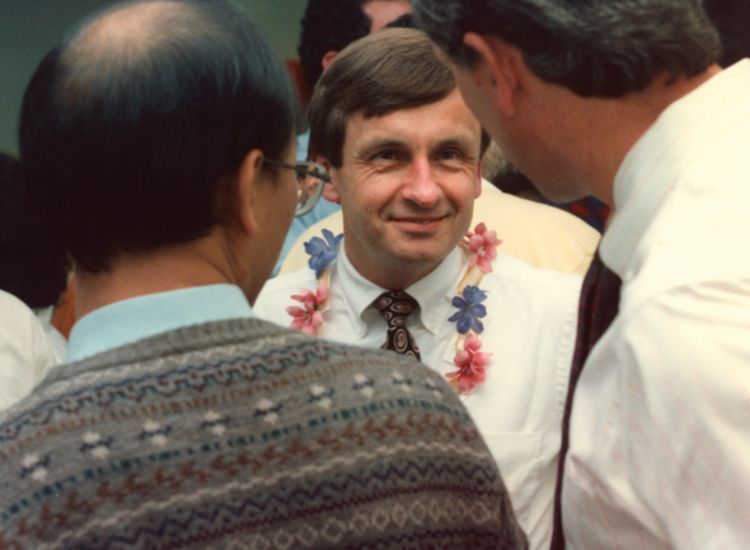
Curran at his farewell party at the CDC, where he led the agency’s response to HIV/AIDS.
Curran at his farewell party at the CDC, where he led the agency’s response to HIV/AIDS.
Curran laughs recalling that when he applied to the Centers for Disease Control and Prevention (CDC) after earning his medical degree at University of Michigan, his resume “was the size of a folded Kleenex.” However, by the time he made his bid to come to Rollins, he had done groundbreaking work on HIV/AIDS at the CDC, rising to the rank of assistant surgeon general. Curran also earned membership in the National Academy of Medicine in 1993.
Not accomplishments to sneeze at, for sure. But as Curran acknowledges, the demands of a dean were different: he had never been an academic, never tried his hand at private philanthropy. As the search committee was deliberating, Dr. William H. Foege, professor emeritus of global health at Rollins, put in a good word—not once but twice—for Curran, who had served under Foege when he was director at the CDC. Both times his advice was, “Jim Curran tops my list. Don’t waste time in securing him.”
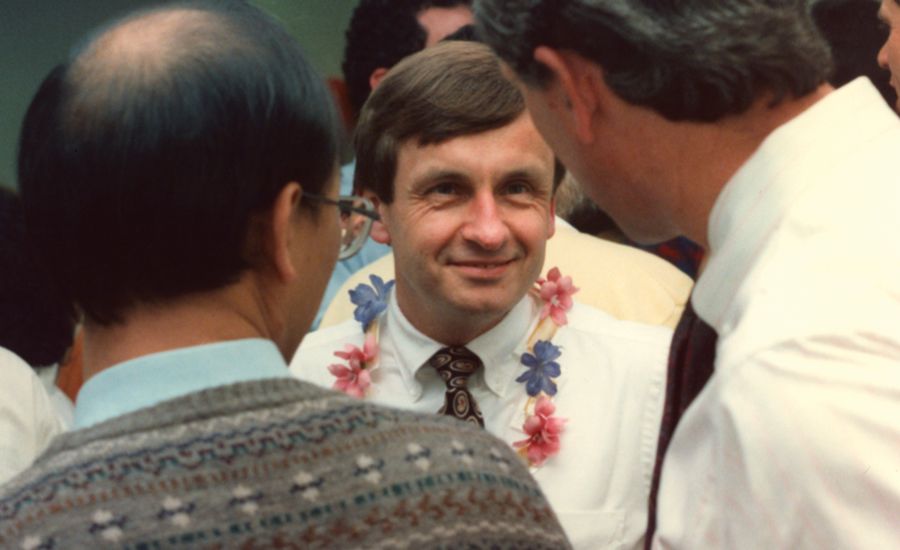
Curran at his farewell party at the CDC, where he led the agency’s response to HIV/AIDS.
Curran at his farewell party at the CDC, where he led the agency’s response to HIV/AIDS.
At age 51, Curran moved into the still not fully occupied 140,000-square-foot Grace Crum Rollins Building, already thinking about what his term of service should be. “I knew that five years would not be enough,” he says. “Ten years seemed like a normal amount of time—and then it just kept on going.”
What follows is about the man who kept it going, in the effort becoming Emory’s longest-serving dean and the longest-serving dean at a school of public health.
The candidate

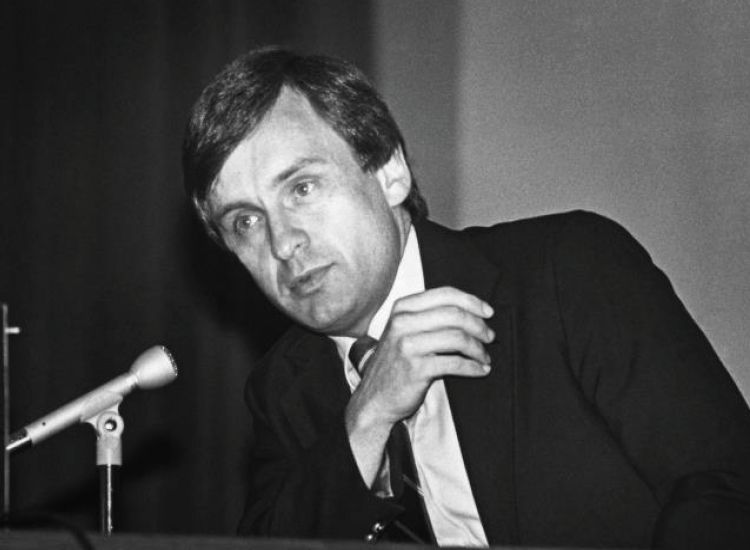
While at the CDC, Curran often presented the agency's latest findings about the mysterious illness that came to be known as AIDS.
While at the CDC, Curran often presented the agency's latest findings about the mysterious illness that came to be known as AIDS.
Something was killing gay men in the early 1980s, and when responsibility for investigating the outbreak was given to Curran—then head of the research branch of the CDC’s Sexually Transmitted Disease Control Division—his life changed forever, as did the lives of those to whom he brought clarity about the disease and, with that, hope.
The task force he was asked to chair was supposed to be active for 90 days; Curran pursued the work for 15 years. June 5th of this year was the 40th anniversary of the publication of the CDC Morbidity and Mortality Weekly Report that carried the news of those first five cases.
Beyond the difficulty of the scientific mystery before him, Curran also had to summon enormous energy. That first year, he went to New York City 40 times, arriving on Mondays and leaving on Fridays—when the 1981 air traffic controller’s strike wasn’t bolloxing up those plans.
Drive was never in short supply, nor courage. There were high and low moments interacting with the gay community, all of which Curran took in stride. Members of Act Up chained themselves to his office door. At one point, 20,000 postcards were sent to his home bearing an image of him on one side and a target on the other.
Curran was empathetic because he understood that “the activists were fighting for their lives.” As far as he was concerned, “it was an important problem,” and anything he had to endure to get to a solution “was just part of the job.”
Says Dr. Michael M.E. Johns, the inaugural Michael M.E. Johns Chair in Health Policy at Rollins, emeritus executive vice president for health affairs at Emory, and emeritus president and CEO of Emory Healthcare: “He had to figure it all out, put the pieces together. There was no script. He went to New York and California looking for clues. He had the notion that this was an infectious disease.”
The case definition Curran’s task force established was adopted worldwide, allowing early and consistent recognition of the AIDS epidemic. In reflecting on that time, Curran says, “The most important thing we did was come out with prevention recommendations before the cause was found. If you read those recommendations today, they sound pretty good.”
Awards poured in for his work. One of the highest honors, though, came not in the form of a statue or certificate: Curran inspired Dr. Robert Gallo—co-discoverer of HIV as the cause of AIDS—to change his focus from cancer to AIDS. It was a banner day on May 4, 1984, when Gallo’s work was published in Science, providing hope that more barriers to knowledge of the disease would fall.
In gifting a copy of Virus Hunting: AIDS, Cancer, and the Human Retrovirus to Curran, Gallo wrote: “To Jim Curran, the outstanding epidemiologist and the key man in our opening understanding of AIDS the disease, AIDS the epidemic, and AIDS the social problem of our time. Thank you so much for your years of brilliant insights and stimulating discussions and especially for your open-ended generosity with ideas.”
While one might gain a taste for all the attention that came of being a leading investigator into HIV/AIDS, Curran is not that person. He sees the principal value of his reputation as being what it can do to advance health.
An example is Emory’s Center for AIDS Research (CFAR), where Curran was co-director until stepping down in January 2021. It was, says Kathryn Graves, senior associate dean for advancement and alumni engagement at Rollins, “established in 1998 largely on Jim’s reputation; he was the PI on that first submission.” Now jointly headed by Drs. Ann Chahroudi, Colleen Kelley, and Carlos del Rio, Emory’s CFAR is one of the largest in the country with nine ‘cores’; its research focus areas extend from HIV risk factors to HIV cure. Emory’s unit has had particular success attracting nationally recognized HIV investigators in the past 20 years. Funded by the NIH, the 17 CFARs at academic and research institutions throughout the United States support multidisciplinary research aimed at reducing the burden of HIV.
Says del Rio, who is also executive associate dean, Emory School of Medicine and the Grady Health System; distinguished professor of infectious diseases, School of Medicine; professor of epidemiology and global health, Rollins: “Dr. Curran has taken Rollins to unimaginable levels by always putting people first and ensuring that the right faculty are recruited, nurtured, and retained. He is an excellent listener, a thoughtful problem solver, and a voice of reason.”
Of the work they have shared at CFAR, del Rio comments: “Establishing the Emory CFAR is one of Jim’s most important contributions. His selfless leadership allowed it to grow as a university-wide initiative that has benefited everyone at Emory. All of us who have worked with the dean have learned about leadership from one of the masters.”
Something was killing gay men in the early 1980s, and when responsibility for investigating the outbreak was given to Curran—then head of the research branch of the CDC’s Sexually Transmitted Disease Control Division—his life changed forever, as did the lives of those to whom he brought clarity about the disease and, with that, hope.
The task force he was asked to chair was supposed to be active for 90 days; Curran pursued the work for 15 years. June 5th of this year was the 40th anniversary of the publication of the CDC Morbidity and Mortality Weekly Report that carried the news of those first five cases.
Beyond the difficulty of the scientific mystery before him, Curran also had to summon enormous energy. That first year, he went to New York City 40 times, arriving on Mondays and leaving on Fridays—when the 1981 air traffic controller’s strike wasn’t bolloxing up those plans.
Drive was never in short supply, nor courage. There were high and low moments interacting with the gay community, all of which Curran took in stride. Members of Act Up chained themselves to his office door. At one point, 20,000 postcards were sent to his home bearing an image of him on one side and a target on the other.

While at the CDC, Curran often presented the agency's latest findings about the mysterious illness that came to be known as AIDS.
While at the CDC, Curran often presented the agency's latest findings about the mysterious illness that came to be known as AIDS.
Curran was empathetic because he understood that “the activists were fighting for their lives.” As far as he was concerned, “it was an important problem,” and anything he had to endure to get to a solution “was just part of the job.”
Says Dr. Michael M.E. Johns, the inaugural Michael M.E. Johns Chair in Health Policy at Rollins, emeritus executive vice president for health affairs at Emory, and emeritus president and CEO of Emory Healthcare: “He had to figure it all out, put the pieces together. There was no script. He went to New York and California looking for clues. He had the notion that this was an infectious disease.”
The case definition Curran’s task force established was adopted worldwide, allowing early and consistent recognition of the AIDS epidemic. In reflecting on that time, Curran says, “The most important thing we did was come out with prevention recommendations before the cause was found. If you read those recommendations today, they sound pretty good.”
Awards poured in for his work. One of the highest honors, though, came not in the form of a statue or certificate: Curran inspired Dr. Robert Gallo—co-discoverer of HIV as the cause of AIDS—to change his focus from cancer to AIDS. It was a banner day on May 4, 1984, when Gallo’s work was published in Science, providing hope that more barriers to knowledge of the disease would fall.
In gifting a copy of Virus Hunting: AIDS, Cancer, and the Human Retrovirus to Curran, Gallo wrote: “To Jim Curran, the outstanding epidemiologist and the key man in our opening understanding of AIDS the disease, AIDS the epidemic, and AIDS the social problem of our time. Thank you so much for your years of brilliant insights and stimulating discussions and especially for your open-ended generosity with ideas.”
While one might gain a taste for all the attention that came of being a leading investigator into HIV/AIDS, Curran is not that person. He sees the principal value of his reputation as being what it can do to advance health.
An example is Emory’s Center for AIDS Research (CFAR), where Curran was co-director until stepping down in January 2021. It was, says Kathryn Graves, senior associate dean for advancement and alumni engagement at Rollins, “established in 1998 largely on Jim’s reputation; he was the PI on that first submission.” Now jointly headed by Drs. Ann Chahroudi, Colleen Kelley, and Carlos del Rio, Emory’s CFAR is one of the largest in the country with nine ‘cores’; its research focus areas extend from HIV risk factors to HIV cure. Emory’s unit has had particular success attracting nationally recognized HIV investigators in the past 20 years. Funded by the NIH, the 17 CFARs at academic and research institutions throughout the United States support multidisciplinary research aimed at reducing the burden of HIV.
Says del Rio, who is also executive associate dean, Emory School of Medicine and the Grady Health System; distinguished professor of infectious diseases, School of Medicine; professor of epidemiology and global health, Rollins: “Dr. Curran has taken Rollins to unimaginable levels by always putting people first and ensuring that the right faculty are recruited, nurtured, and retained. He is an excellent listener, a thoughtful problem solver, and a voice of reason.”
Of the work they have shared at CFAR, del Rio comments: “Establishing the Emory CFAR is one of Jim’s most important contributions. His selfless leadership allowed it to grow as a university-wide initiative that has benefited everyone at Emory. All of us who have worked with the dean have learned about leadership from one of the masters.”
Student champion

Curran learned an early lesson about students from Charles Ginden.
In discussing his vision for the school, Kara Robinson says, Curran was “rattling off plans to increase research and recruit the best faculty.” Ginden, an Emory trustee at the time, stopped him, asking, “But what about the students?” It was a pivotal moment. Since then, the Rollins footprint has followed the growth of student interest in the school.
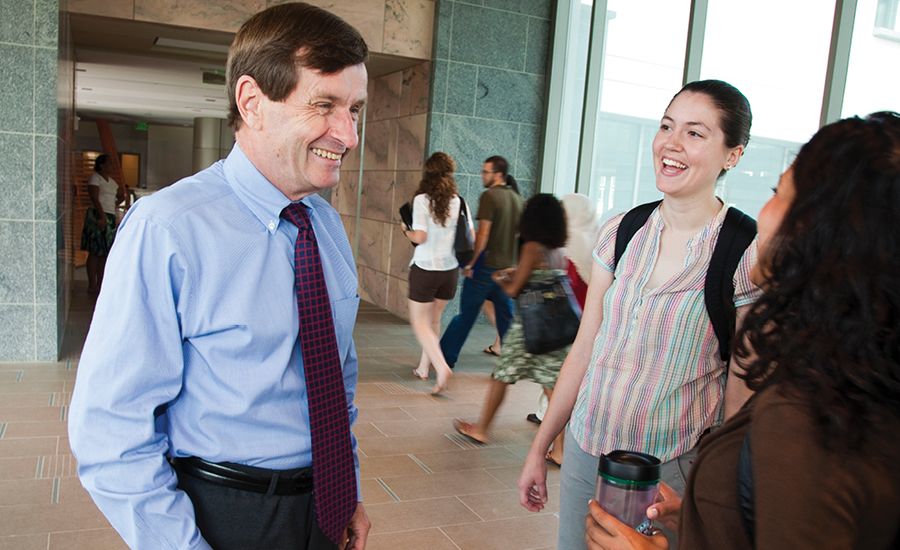
Curran can often be seen in the school’s hallways, chatting and joking with students.
Curran can often be seen in the school’s hallways, chatting and joking with students .
When Robinson, associate dean of admission and student affairs, arrived in 2001, she describes a situation unthinkable today: “No one really understood what public health was, even our students.”
“Now,” says Curran, “everyone better understands public health’s principles of prevention, of understanding social determinants of health, and of detecting early infectious diseases and chronic diseases before they become terrible burdens.”
When Robinson joined, there were about 30 schools of public health in the country; that figure has more than doubled. Rollins was once the only school of public health in Georgia, and now there are neighboring programs at University of Georgia, Georgia State University, Georgia Southern University, and Mercer University.

Curran learned an early lesson about students from Charles Ginden.
In discussing his vision for the school, Kara Robinson says, Curran was “rattling off plans to increase research and recruit the best faculty.” Ginden, an Emory trustee at the time, stopped him, asking, “But what about the students?” It was a pivotal moment. Since then, the Rollins footprint has followed the growth of student interest in the school.
When Robinson, associate dean of admission and student affairs, arrived in 2001, she describes a situation unthinkable today: “No one really understood what public health was, even our students.”
“Now,” says Curran, “everyone better understands public health’s principles of prevention, of understanding social determinants of health, and of detecting early infectious diseases and chronic diseases before they become terrible burdens.”
When Robinson joined, there were about 30 schools of public health in the country; that figure has more than doubled. Rollins was once the only school of public health in Georgia, and now there are neighboring programs at University of Georgia, Georgia State University, Georgia Southern University, and Mercer University.

Going global

Given the range of choice available to students, academic programming matters. One signature of Curran’s tenure is the fact that Rollins was the first public health school to have a global health department. The master’s program includes options in global environmental health, global epidemiology, and global health.
Foege, who is writing a book on global health, says that before the Bill & Melinda Gates Foundation started funding initiatives such as the program named for him, the William H. Foege Global Health Fellowship program, “those of us in global health thought like poor people and never took that big-picture look at problems.”
Gates money changed that, but so did having a leader like Curran. Notes Foege, “Jim thought globally right from the beginning. He has a passion for this work, and people are willing to follow him.”
In addition to the Foege fellowships, the Hubert H. Humphrey Fellowship program attracts midcareer professionals from countries around the world. Moreover, the school has a number of Gates Millennium Scholars, students from underrepresented backgrounds, and it attracts many Peace Corps volunteers with global field experience.
“Just having these fantastic students in the school adds to the discussions in the classroom. These are not just book-smart students; they have field experience and can draw on their diverse perspectives,” says Robinson.
Foege credits Curran with being attuned to two key markers of student success: mentorship and internships. With the wealth of partners the school enjoys, internship opportunities are numerous, including immersion in other cultures.
Curran urges students to network, saying, “Although great breakthroughs can be done alone in a laboratory, in general you need partnerships with community organizations, the populations most affected, and industry.”
He is the rare dean with his door wide open to students. Every five years at orientation, the students read And the Band Played On: Politics, People, and the AIDS Epidemic, in which he is a central figure, and Curran delivers a keynote on the history of HIV/AIDS. “It is something students never forget. They are reading this book and then seeing the real-life public health hero in front of them,” says Robinson.

‘The principles’

A faculty member himself, Curran is professor of epidemiology at Rollins and holds faculty appointments in the Emory School of Medicine and Nell Hodgson Woodruff School of Nursing.
In Curran’s view, “To recruit great students, you must have great faculty. And you can’t recruit great faculty without money.” Curran refers to this stepwise process as “the principles.”
By all measures, Curran has built a distinguished faculty—and not just the more than 200 full-time faculty but also the 250 adjunct faculty who hail from the CDC, CARE, the Task Force for Global Health, The Carter Center, and state and local health departments.
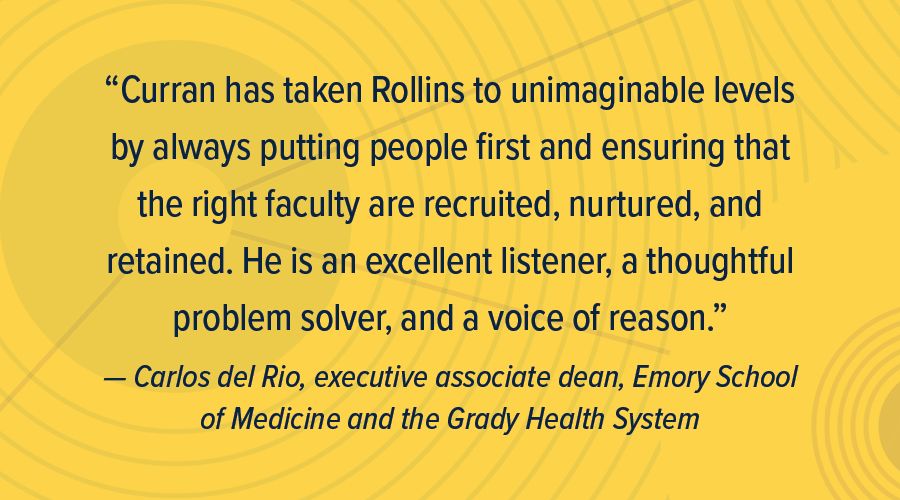
The faculty excel at both teaching and research, influencing national conversations on opioid abuse, prison health, diabetes, health disparities, COVID-19 transmission, Medicaid policy, reproductive health, mental health, environmental health, HIV/AIDS, maternal mortality, and more.
“Jim understood that to be an effective leader, you have to head a coalition, and a coalition that really works provides both executive and congressional leadership,” says Foege. “He also exerts considerable effort to position the best people around him.”
At CFAR, Curran helped lead more than 120 faculty working on $70 million per year of projects throughout the world in basic science as well as behavioral science and global health.

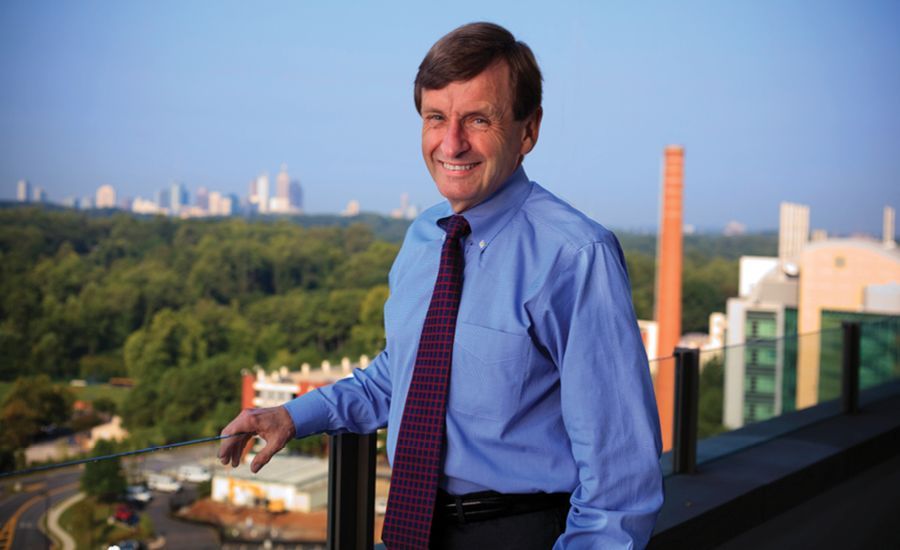
A faculty member himself, Curran is professor of epidemiology at Rollins and holds faculty appointments in the Emory School of Medicine and Nell Hodgson Woodruff School of Nursing.
In Curran’s view, “To recruit great students, you must have great faculty. And you can’t recruit great faculty without money.” Curran refers to this stepwise process as “the principles.”
By all measures, Curran has built a distinguished faculty—and not just the more than 200 full-time faculty but also the 250 adjunct faculty who hail from the CDC, CARE, the Task Force for Global Health, The Carter Center, and state and local health departments.

The faculty excel at both teaching and research, influencing national conversations on opioid abuse, prison health, diabetes, health disparities, COVID-19 transmission, Medicaid policy, reproductive health, mental health, environmental health, HIV/AIDS, maternal mortality, and more.
“Jim understood that to be an effective leader, you have to head a coalition, and a coalition that really works provides both executive and congressional leadership,” says Foege. “He also exerts considerable effort to position the best people around him.”
At CFAR, Curran helped lead more than 120 faculty working on $70 million per year of projects throughout the world in basic science as well as behavioral science and global health.
Building a top-tier faculty

Dr. Kimberly Jacob Arriola—the Charles Howard Candler Professor of Behavioral, Social, and Health Education Sciences—was executive associate dean for academic affairs at Rollins before assuming her new role as dean of the Laney Graduate School on September 1, 2021. It is a breathtaking rise for someone who joined Rollins as a postdoctoral master’s student in 1998.
As someone who likes “hard things,” Arriola set ambitious goals for herself, yet she also is quick to credit Curran. Arriola had been director of graduate studies for six years but had limited administrative experience before joining the dean’s office. She acknowledges that Curran’s belief in her was thicker than her resume. “What he saw in me was potential,” Arriola notes. “He gave me the resources and support that I needed to do well in my job. He doesn’t micromanage. He likes to let people just run,” she says.
Arriola is keenly aware that she is not alone, that Curran demonstrates an uncanny ability to identify talent and then align people’s strengths with the work they do.
“He deeply understands that faculty are the lifeblood of the school, and so recruiting and retaining an eminent faculty is really central to our success,” says Arriola. “He puts a lot of energy into helping empower the chairs of the departments to recruit the leading scholars, instructors, and practitioners in the field.”
At conferences, on panels, wherever the best of class in public health congregate, there is respect for Curran. According to Arriola, “Jim’s stature in the field helps us tremendously. He is an icon because of his enormous contributions over the span of a 50-year career.”
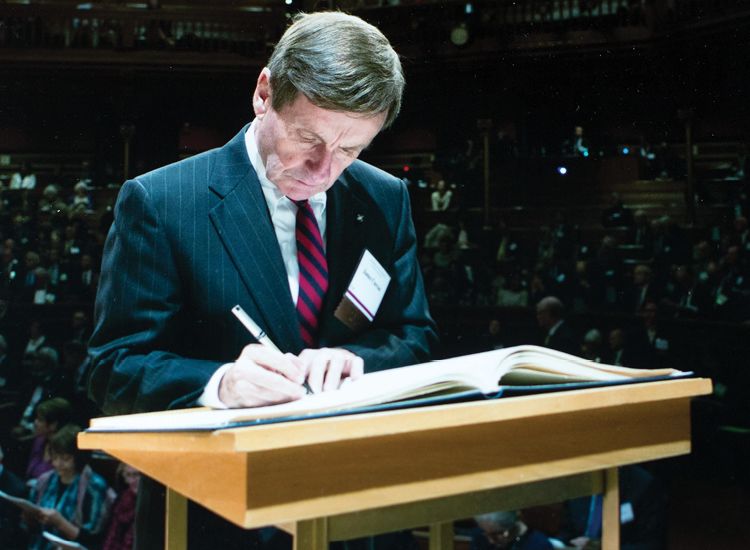
Curran at his induction to the American Academy of Arts and Sciences.
Curran at his induction to the American Academy of Arts and Sciences.
Dr. Kimberly Jacob Arriola—the Charles Howard Candler Professor of Behavioral, Social, and Health Education Sciences—was executive associate dean for academic affairs at Rollins before assuming her new role as dean of the Laney Graduate School on September 1, 2021. It is a breathtaking rise for someone who joined Rollins as a postdoctoral master’s student in 1998.
As someone who likes “hard things,” Arriola set ambitious goals for herself, yet she also is quick to credit Curran. Arriola had been director of graduate studies for six years but had limited administrative experience before joining the dean’s office. She acknowledges that Curran’s belief in her was thicker than her resume. “What he saw in me was potential,” Arriola notes. “He gave me the resources and support that I needed to do well in my job. He doesn’t micromanage. He likes to let people just run,” she says.

Curran at his induction to the American Academy of Arts and Sciences.
Curran at his induction to the American Academy of Arts and Sciences.
Arriola is keenly aware that she is not alone, that Curran demonstrates an uncanny ability to identify talent and then align people’s strengths with the work they do.
“He deeply understands that faculty are the lifeblood of the school, and so recruiting and retaining an eminent faculty is really central to our success,” says Arriola. “He puts a lot of energy into helping empower the chairs of the departments to recruit the leading scholars, instructors, and practitioners in the field.”
At conferences, on panels, wherever the best of class in public health congregate, there is respect for Curran. According to Arriola, “Jim’s stature in the field helps us tremendously. He is an icon because of his enormous contributions over the span of a 50-year career.”
A research enterprise

“Jim is a person who understands the challenges and excitement of research,” says Dr. Carmen Marsit, associate dean for research and Rollins Distinguished Professor of Research. A faculty member in environmental health with a joint appointment in epidemiology, Marsit stepped into the associate dean role in December 2019.
Rollins faculty pursue different kinds of research: quantitative, qualitative, laboratory, and community engaged. Their work also spans broad areas, including infectious and noncommunicable disease, health disparities and social determinants, climate change, environmental exposures, as well as policy interventions and methods. The common denominator among the researchers, according to Marsit, is dedication and talent.
“What Jim had in mind for my position is enabling the faculty to do the work that they are truly passionate about,” says Marsit, who provides support and resources, especially focusing on early-career researchers.
To level the playing field, the school is moving from a network model of research mentoring—where faculty call upon an established group of mentors—to a more school-wide model offering workshops and seminars. Another aspect of that, says Marsit, is being “transparent about the support we provide our researchers—for instance, writing down policies so everyone can access them” and having pilot grants available that especially benefit early-career faculty.
The next wave of growth for Rollins researchers will be what Marsit terms “crossover research,” that is, additional interdisciplinary activity. For example, he cited work in cancer, cardiovascular disease, and environmental exposures that is taking account of social determinants and structural racism.
Just months into Marsit’s tenure, in March 2020, the prevailing question became the fate of the school’s research during the pandemic. “How would we continue to do research if we couldn’t come into the office? This is where working with Jim taught me a lot. He looked to everyone on his leadership team to alleviate challenges that people were facing. He put a lot on us but trusted us to execute smart plans,” Marsit says.
He recalls his interview with Curran. He expected the process to be intimidating. Instead, “He was very warm. He did ask a lot of questions, but he was getting at who I was and not just asking about my research. He sees people’s personalities as an important facet of the contribution they will make, which is part of what makes this a special place.”
No stranger to having served at fine institutions in his professional life, Marsit describes the Rollins difference, saying, “Just walking back in here, as we did this fall, the energy and passion that our people have make it an entirely different world. Faculty are excited to be here and innovating in both research and teaching. We are buzzing.”

“Jim is a person who understands the challenges and excitement of research,” says Dr. Carmen Marsit, associate dean for research and Rollins Distinguished Professor of Research. A faculty member in environmental health with a joint appointment in epidemiology, Marsit stepped into the associate dean role in December 2019.
Rollins faculty pursue different kinds of research: quantitative, qualitative, laboratory, and community engaged. Their work also spans broad areas, including infectious and noncommunicable disease, health disparities and social determinants, climate change, environmental exposures, as well as policy interventions and methods. The common denominator among the researchers, according to Marsit, is dedication and talent.
“What Jim had in mind for my position is enabling the faculty to do the work that they are truly passionate about,” says Marsit, who provides support and resources, especially focusing on early-career researchers.

The 2008 groundbreaking of the Claudia Nance Rollins Building, l-r: Gary W. Rollins; Fred Sanfilippo, CEO, Woodruff Health Sciences Center; James Wagner, President, Emory University; Ben Johnson, Board of Trustees Chairman, Emory University; Dean James Curran; Amy Rollins Kreisler; R. Randall Rollins; Michael M.E. Johns, Chancellor, Emory University.
The 2008 groundbreaking of the Claudia Nance Rollins Building, l-r: Gary W. Rollins; Fred Sanfilippo, CEO, Woodruff Health Sciences Center; James Wagner, President, Emory University; Ben Johnson, Board of Trustees Chairman, Emory University; Dean James Curran; Amy Rollins Kreisler; R. Randall Rollins; Michael M.E. Johns, Chancellor, Emory University.
To level the playing field, the school is moving from a network model of research mentoring—where faculty call upon an established group of mentors—to a more school-wide model offering workshops and seminars. Another aspect of that, says Marsit, is being “transparent about the support we provide our researchers—for instance, writing down policies so everyone can access them” and having pilot grants available that especially benefit early-career faculty.
The next wave of growth for Rollins researchers will be what Marsit terms “crossover research,” that is, additional interdisciplinary activity. For example, he cited work in cancer, cardiovascular disease, and environmental exposures that is taking account of social determinants and structural racism.
Just months into Marsit’s tenure, in March 2020, the prevailing question became the fate of the school’s research during the pandemic. “How would we continue to do research if we couldn’t come into the office? This is where working with Jim taught me a lot. He looked to everyone on his leadership team to alleviate challenges that people were facing. He put a lot on us but trusted us to execute smart plans,” Marsit says.
He recalls his interview with Curran. He expected the process to be intimidating. Instead, “He was very warm. He did ask a lot of questions, but he was getting at who I was and not just asking about my research. He sees people’s personalities as an important facet of the contribution they will make, which is part of what makes this a special place.”
No stranger to having served at fine institutions in his professional life, Marsit describes the Rollins difference, saying, “Just walking back in here, as we did this fall, the energy and passion that our people have make it an entirely different world. Faculty are excited to be here and innovating in both research and teaching. We are buzzing.”

With great management comes strong investment

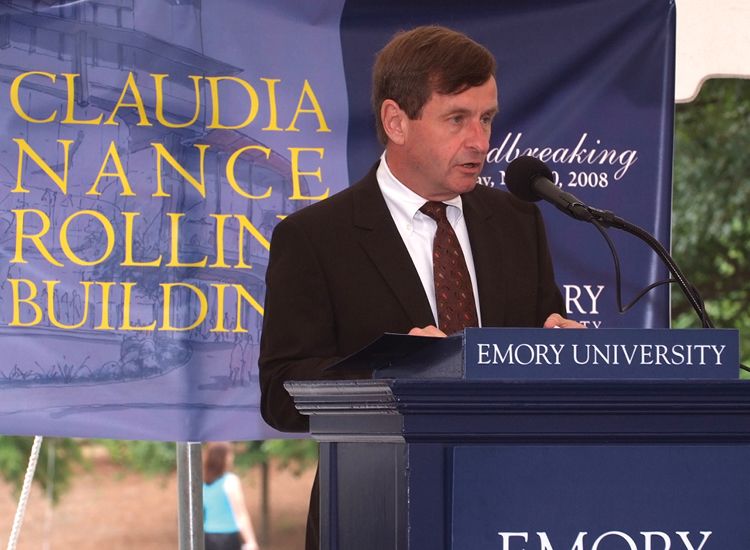
Curran speaks at the groundbreaking of the Claudia Nance Rollins Building.
Curran speaks at the groundbreaking of the Claudia Nance Rollins Building.
Fundraising might have been the last arrow added to the bulging Curran quiver, but he learned to do the work with surpassing skill by understanding that, as he notes, “you have to match donor interests and gain their trust as a good steward of the investments they make.”
Graves says that before the Grace Crum Rollins Building opened in 1994, “it was hard for people to understand that we existed. Once the building went up, it was clear that we were a viable entity.”
That viability, in large part, stems from a multigenerational relationship with the Rollins family that began with the largesse of O. Wayne and Grace Crum Rollins, their children Randall and Gary, and now Amy Rollins Kreisler, daughter of Randall Rollins and executive director of the O. Wayne Rollins Foundation, as well as her siblings Pamela, Richard, Robert, and Timothy Rollins.
Graves knows how unusual it has been for her and Curran to work with the family across generations. She calls it “an amazing privilege, one I treasure.” The trust that Curran has built with the Rollins family “is at the heart of the school’s success,” she says.
“The family is very proud of what we built,” Graves adds. “We work every day to make the school the best it can be. We have more than 11,000 alumni in more than 100 countries. They proudly carry the Rollins name throughout the world.”
Having such longstanding, generous donors as the Rollins family might cause some deans to be less attentive to fundraising as a whole. Not so Curran: he calls everyone who gives $500 or more. “In this way,” he says, “people know that you personally care about their gift. For some donors, that means a lot.”
Curran put a priority on endowment—what he calls the “third rail” after tuition and research dollars. He used a generous, unrestricted gift from Grace Crum Rollins to establish the O. Wayne and Grace Crum Rollins Endowment Fund. In the ensuing years, more than 100 endowment accounts have been created, and the school’s endowment now stands at more than $153 million. In fact, Rollins has two endowed departments—the Hubert Department of Global Health and the Gangarosa Department of Environmental Health—the only ones solely at Emory.
Kreisler knows Curran as a man of his word, delivering the Claudia Nance Rollins Building on time and within budget and poised to do the same for the R. Randall Rollins Building, named for her father. “Jim has done an amazing job leading the school, making it a comfortable decision for us to support its success over the years,” she says.
Says Curran, “What Randall Rollins cared about was ‘what is happening with the school that our name is on?’ My role was to come up with strategies for how best to use the endowment money—whether for faculty chairs or junior faculty—to show that his investment would help us in an enduring way and why it was crucial to keep renewing it.”
As Kreisler grew into the role she now occupies, she had a bird’s-eye view of the family’s relationship with Curran. “Jim’s credentials were so impressive already; it was natural to embrace him and see what he could do for the school,” she says.
She is serving on the search committee for Curran’s successor based, she says, on the fact that “Jim is leaving such a legacy of strength, and we want to see that strength continue.”
Fundraising might have been the last arrow added to the bulging Curran quiver, but he learned to do the work with surpassing skill by understanding that, as he notes, “you have to match donor interests and gain their trust as a good steward of the investments they make.”
Graves says that before the Grace Crum Rollins Building opened in 1994, “it was hard for people to understand that we existed. Once the building went up, it was clear that we were a viable entity.”
That viability, in large part, stems from a multigenerational relationship with the Rollins family that began with the largesse of O. Wayne and Grace Crum Rollins, their children Randall and Gary, and now Amy Rollins Kreisler, daughter of Randall Rollins and executive director of the O. Wayne Rollins Foundation, as well as her siblings Pamela, Richard, Robert, and Timothy Rollins.
Graves knows how unusual it has been for her and Curran to work with the family across generations. She calls it “an amazing privilege, one I treasure.” The trust that Curran has built with the Rollins family “is at the heart of the school’s success,” she says.
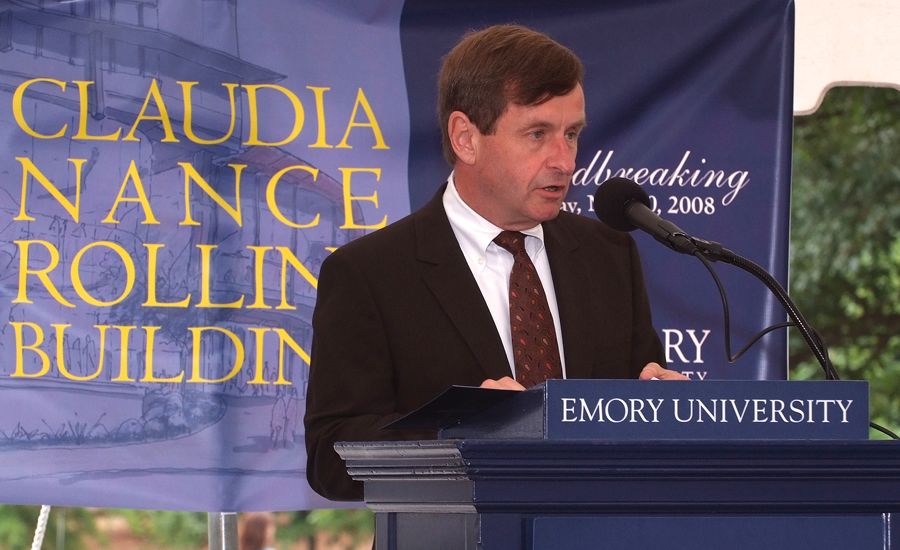
Curran speaks at the groundbreaking of the Claudia Nance Rollins Building.
Curran speaks at the groundbreaking of the Claudia Nance Rollins Building.
“The family is very proud of what we built,” Graves adds. “We work every day to make the school the best it can be. We have more than 11,000 alumni in more than 100 countries. They proudly carry the Rollins name throughout the world.”
Having such longstanding, generous donors as the Rollins family might cause some deans to be less attentive to fundraising as a whole. Not so Curran: he calls everyone who gives $500 or more. “In this way,” he says, “people know that you personally care about their gift. For some donors, that means a lot.”
Curran put a priority on endowment—what he calls the “third rail” after tuition and research dollars. He used a generous, unrestricted gift from Grace Crum Rollins to establish the O. Wayne and Grace Crum Rollins Endowment Fund. In the ensuing years, more than 100 endowment accounts have been created, and the school’s endowment now stands at more than $153 million. In fact, Rollins has two endowed departments—the Hubert Department of Global Health and the Gangarosa Department of Environmental Health—the only ones solely at Emory.
Kreisler knows Curran as a man of his word, delivering the Claudia Nance Rollins Building on time and within budget and poised to do the same for the R. Randall Rollins Building, named for her father. “Jim has done an amazing job leading the school, making it a comfortable decision for us to support its success over the years,” she says.
Says Curran, “What Randall Rollins cared about was ‘what is happening with the school that our name is on?’ My role was to come up with strategies for how best to use the endowment money—whether for faculty chairs or junior faculty—to show that his investment would help us in an enduring way and why it was crucial to keep renewing it.”
As Kreisler grew into the role she now occupies, she had a bird’s-eye view of the family’s relationship with Curran. “Jim’s credentials were so impressive already; it was natural to embrace him and see what he could do for the school,” she says.
She is serving on the search committee for Curran’s successor based, she says, on the fact that “Jim is leaving such a legacy of strength, and we want to see that strength continue.”
Turning the wheels for public health writ large

Where he finds the time to do it, no one knows, but Curran has contributed substantially both to the Georgia Department of Public Health (GDPH) and the Association of Schools and Programs of Public Health (ASPPH).
For nearly 20 years, Curran has served on the board of the GDPH. As chair of the board since 2019, his counsel has been of immense value to Commissioner Kathleen Toomey as Georgia has sought to tamp down COVID-19.
Representing schools and programs accredited by the Council on Education for Public Health, ASPPH has 134 member institutions, including five international. Curran chaired the board of directors from 2005 to 2007, currently chairs the group’s Global Engagement and Partnerships Advisory Committee, and helped launch the Global Network for Academic Public Health.
Says Laura Magaña, the CEO and president, “As chair and in all the roles he has graciously assumed on behalf of ASPPH, Jim is always innovating, engaging, and caring. He consistently challenges all of us to think outside the box—driving the field of public health further. He leads with incredible passion, vision, and has a wicked sense of humor that keeps us laughing even under the most stressful situations.”
Dean Surbey, executive associate dean of administration and finance at Rollins, has been alongside Curran from the start, watching his level of commitment to ASPPH. “He knows all the deans and commands their respect,” says Surbey. “You cannot underestimate that power.”
As she ticked down a long list of things she admires about Curran, Magaña took a breath and said, “There is just no one like him. He’s Jim, right?”
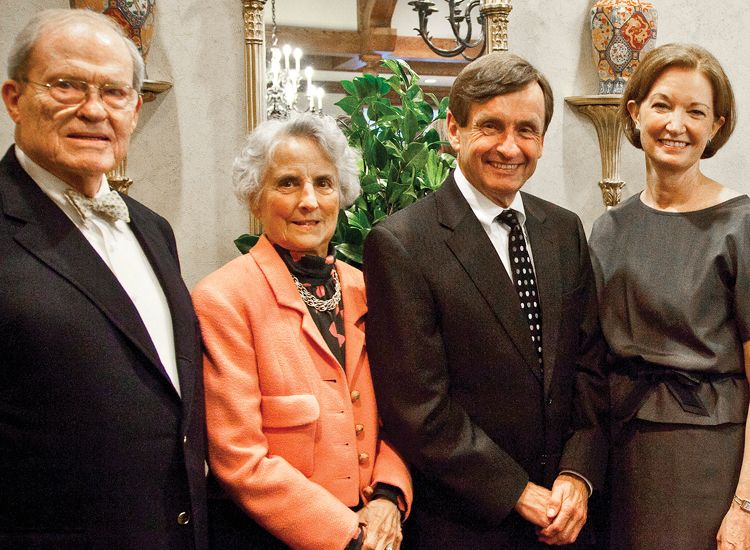
L-r: James Laney, former Emory University President, Berta Laney, Curran, and Ginny Bales Harris 71C 77MPH
L-r: James Laney, former Emory University President, Berta Laney, Curran, and Ginny Bales Harris 71C 77MPH
Where he finds the time to do it, no one knows, but Curran has contributed substantially both to the Georgia Department of Public Health (GDPH) and the Association of Schools and Programs of Public Health (ASPPH).
For nearly 20 years, Curran has served on the board of the GDPH. As chair of the board since 2019, his counsel has been of immense value to Commissioner Kathleen Toomey as Georgia has sought to tamp down COVID-19.
Representing schools and programs accredited by the Council on Education for Public Health, ASPPH has 134 member institutions, including five international. Curran chaired the board of directors from 2005 to 2007, currently chairs the group’s Global Engagement and Partnerships Advisory Committee, and helped launch the Global Network for Academic Public Health.
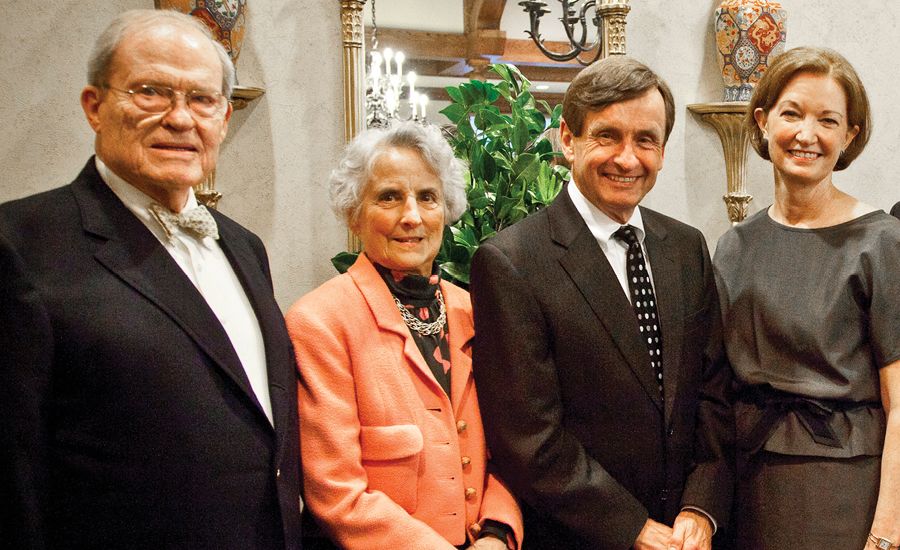
L-r: James Laney, former Emory University President, Berta Laney, Curran, and Ginny Bales Harris 71C 77MPH
L-r: James Laney, former Emory University President, Berta Laney, Curran, and Ginny Bales Harris 71C 77MPH
Says Laura Magaña, the CEO and president, “As chair and in all the roles he has graciously assumed on behalf of ASPPH, Jim is always innovating, engaging, and caring. He consistently challenges all of us to think outside the box—driving the field of public health further. He leads with incredible passion, vision, and has a wicked sense of humor that keeps us laughing even under the most stressful situations.”
Dean Surbey, executive associate dean of administration and finance at Rollins, has been alongside Curran from the start, watching his level of commitment to ASPPH. “He knows all the deans and commands their respect,” says Surbey. “You cannot underestimate that power.”
As she ticked down a long list of things she admires about Curran, Magaña took a breath and said, “There is just no one like him. He’s Jim, right?”
“He’s Jim, right?”

As he thinks back on nearly three decades of progress at Rollins, Curran says, “We were the youngest, smallest, least endowed, least respected school on campus. Now Emory, instead of worrying about us, is proud of us. That is also the case among schools and programs of public health.”
Arriola acknowledges that although it is “normal and healthy to worry about the school after Jim steps down, we will be fine. He has secured our future.”
It will surprise no one to hear that, with his characteristic brio, Curran is urging everyone at the school “not to take your foot off the gas.”
The next dean will share a name with Curran, given that the deanship was endowed and named for him in 2009. He is the only sitting dean at Emory ever to have the position named for him.
Asked what the crowning moment of his career is, most respondents quailed at the hard choice between his contributions to HIV/AIDS and his achievements at Rollins.
Credit Foege with the most intriguing answer. When asked about the high mark of Curran’s career, he responded, “We don’t know yet.”
That would be some third act.
Story by Susan Carini 04G
Designed by Linda Dobson
Illustration by Nigel Buchanan
Background image: Curran reacts to the announcement of the James W. Curran scholarship, which included a $10 million gift from the Rollins family.

Fun Facts about the Dean

- Very, very conversational. According to
Michael M.E. Johns, “he could talk to a lamppost.” - His ability to pick good restaurants is unerring, his golf game not so much.
- Devilish sense of Irish humor.
- His father wanted him to get an engineering and law degree.
- A graduate of both the University of Notre Dame (BS, 1966) and the University of Michigan (MD, 1970), he roots for Notre Dame in football, deeply disappointing his Michigan classmates.
- Reads constantly, even at stoplights.
- Respects the value of a Rollins dollar. William Foege remains suspicious that the dean furnished Foege’s office with furniture from Goodwill. (According to the dean, “He should be grateful.”)
- Needs little sleep.
- Hates a fuss about his birthday, usually opting for breakfast with the staff.
- Donned a pair of stilts to play the 6’ 7“ Foege in a roast at Foege’s retirement party.
- Originally planned to be an OB/GYN. Medical school classmate Johns, asked if there were any clues about Curran entering public health as a career, said “No way.”
- It was the dean who began referring to Atlanta as the “public health capital of the world.” According to Kathryn Graves, he started saying it mere months into his tenure. “Can we say that?,” Graves asked. “I just did,” he responded.


Want to know more? Please visit
Rollins Magazine
Emory News Center
Emory University

